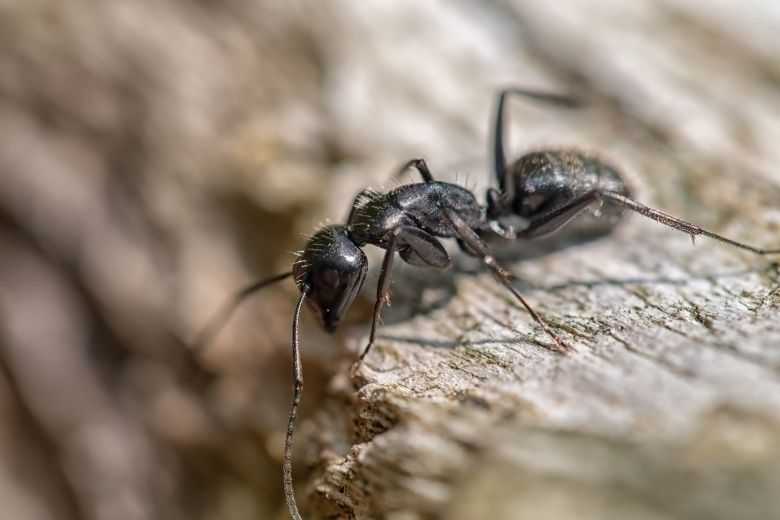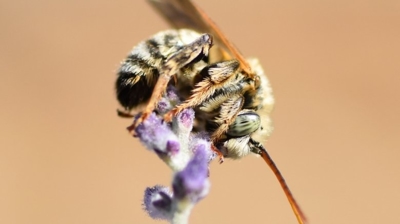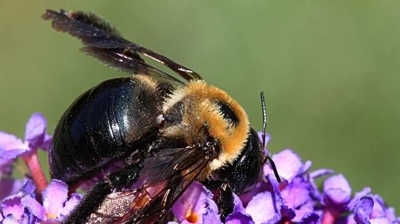
Carpenter Ant Control Services

Carpenter Ants
Carpenter ants can be considered dangerous in several ways. Here are some of the ways in which carpenter ants can pose a threat:
- Structural Damage: Carpenter ants are known for excavating wood to create nesting galleries within it. While they don't consume wood for food like termites, their extensive tunneling can weaken the structural integrity of wooden buildings and infrastructure. Over time, this can lead to costly damage and potentially compromise the safety of structures.
- Property Damage: In addition to wooden structures, carpenter ants may nest in other materials such as foam insulation, siding, and even electrical wiring. Their nesting activities can damage these materials, resulting in costly repairs and potential fire hazards if they chew through electrical wiring.
- Vector for Disease: While carpenter ants themselves are not direct vectors of diseases that affect humans, they can transport bacteria and pathogens on their bodies and contaminate food when foraging in human environments. This can pose health risks in certain situations.
- Stress and Allergies: The presence of carpenter ants in a home can be stressful and cause anxiety for homeowners, particularly if they are difficult to control. Additionally, some individuals may experience allergic reactions to ant stings, although carpenter ants are not known for aggressive stinging behavior.
To mitigate the potential dangers of carpenter ants, it is essential to address infestations promptly through effective pest control methods. Regular inspections, proper maintenance of wooden structures, and maintaining a clean and food-safe environment can help prevent carpenter ant issues and reduce the risks associated with their presence.
Learn more: Carpenter Ant Damage || Do Carpenter Ants Bite? || What Do Carpenter Ants Eat?
Carpenter Ant Removal
Carpenter ants aren’t just a nuisance—they’re a structural threat. Here’s why removing them promptly is so important:
- They damage wood—even if they don’t eat it: Carpenter ants excavate galleries inside wood to build their nests. Over time, this hollowing-out weakens structural components such as beams, joists, wall studs, window and door frames, decks, and porches. If left unchecked, damage can become extensive and costly to repair.
- They spread to multiple satellite colonies: A single mature carpenter ant colony will create multiple “satellite” nests throughout a structure. That means even if activity disappears in one area, the infestation can re-emerge elsewhere.
- They’re difficult for homeowners to locate: Carpenter ants can nest in wall voids, insulation, damp or decaying wood, attics, and crawl spaces. They often forage at night, making them hard to detect until the damage is advanced.
- Moisture problems usually accompany them: Carpenter ants prefer damp or water-damaged wood. Their presence often indicates underlying issues like plumbing leaks, roof leaks, drainage problems, and poor ventilation. Ignoring the ants may mean ignoring bigger structural risks.
Carpenter ant colonies can grow to tens of thousands of ants and survive for years. Without targeted elimination, the problem typically escalates.
Learn more: How To Get Rid Of Carpenter Ants
Carpenter Ant Control
Hiring our professional carpenter ant control is the best way to ensure your home or business is protected from costly damage and recurring infestations. Unlike nuisance ants, carpenter ants don’t just forage for food — they tunnel through wood to build their nests, which can compromise the structural integrity of your property if left untreated. While DIY sprays or baits may kill the ants you see, they rarely reach the hidden nests deep inside walls, floors, or roofing.
Our professionals bring expertise, tools, and proven treatment strategies that go beyond surface-level fixes. Our trained exterminators can accurately identify the source of the infestation, locate satellite nests, and target the colony at its root. We also know how to apply treatments safely and effectively, minimizing risks to your family, pets, and environment.
In addition to eliminating current infestations, our professional services include preventative measures. Our pest control experts can identify entry points, assess conditions that attract carpenter ants (such as moisture-damaged wood), and recommend long-term solutions to reduce the chances of future problems.
Ultimately, our professional carpenter ant control saves you money and stress by stopping infestations before they cause major structural damage, while giving you peace of mind that the problem is handled thoroughly and safely.
Carpenter Ant Exterminators
Hiring our local exterminators to eliminate carpenter ants offers advantages that DIY methods and national chains simply can’t match. Here’s why it’s often the smartest and most cost-effective choice:
- Our local pros understand regional carpenter ant behavior: Carpenter ant species and nesting patterns vary by region. Our local professional works with the exact species and environmental conditions in the area every day. We know where colonies typically establish locally, seasonal activity patterns, and which moisture or structural conditions are most commonly associated with infestations in the region. This precision dramatically increases the success rate—and reduces the chance of reinfestation.
- Faster response and more attentive service: Our local team relies heavily on reputation and word-of-mouth. That means quicker scheduling, more thorough inspections, follow-up that doesn’t fall through the cracks, and direct contact with the same technician. National chains focus on volume and standardization; our local exterminators focus on solving the actual problem.
- Targeted, customized treatment: Carpenter ant infestations differ widely from home to home. Our local techs tailor our approach based on the structure’s age and building materials, surrounding vegetation, moisture issues unique to your property, and the exact location of parent vs satellite colonies. National companies often rely on preset service protocols. DIY solutions are usually surface-level and rarely reach the heart of the colony.
- More thorough inspections that address root causes: Carpenter ants are strongly associated with moisture-damaged or compromised wood. Our local exterminators tend to take a whole-home approach by identifying leaks, ventilation problems, structural vulnerabilities, and landscaping issues that promote ant activity. DIY treatments may kill foragers, but without identifying and resolving the moisture or nesting conditions, ants return.
- Access to professional-grade products and precision application: Eliminating carpenter ants requires deep-reach baits, targeted non-repellent treatments, and specialized dust applications to wall voids and structural pockets. These require training and equipment most homeowners don’t have access to.
- Accountability and consistency you won’t get with large franchises: With our local team, service is personal, not transactional. There’s real incentive to solve the issue correctly the first time, and few turnover issues or unfamiliar technicians. You get expertise that stays with your property over time.
Our local exterminators focus on accurate diagnosis, correct treatment, and preventing future problems. This typically saves significantly more money—and frustration—over the life of the home.
What Do Carpenter Ants Look Like?
Carpenter ants exhibit distinct physical characteristics that set them apart from other ant species. Here's a description of what carpenter ants look like:
- Size: Carpenter ants are generally larger than common household ants, measuring between 0.25 to 0.5 inches (6 to 13 mm) in length. This size difference makes them noticeable.
- Color: Their coloration varies but often includes shades of black, red, or a combination of both. Some species may also have brown or yellow hues. Notably, the larger carpenter ants are often black, while smaller ones may be reddish-brown.
- Body Segmentation: Carpenter ants have a distinct body structure composed of three main parts: the head, thorax, and abdomen. The head houses their antennae, which are bent at a noticeable angle.
- Antennae: Their antennae are segmented and elbowed, forming a noticeable "bent" appearance. This feature distinguishes them from other insects like termites, whose antennae are straight.
- Thorax: The thorax, which is the middle part of their body, is where the six legs are attached. The front pair of legs is equipped with strong mandibles (jaws) that carpenter ants use for various tasks, including excavating wood.
- Waist: Carpenter ants have a noticeable waist, which appears pinched or constricted. This waist is called the petiole and separates the thorax from the abdomen.
- Abdomen: The abdomen is the rear part of their body and appears smooth and rounded. Unlike termites, carpenter ants do not have wings of equal size.
- Winged Reproductive Forms: In certain seasons, carpenter ant colonies produce winged male and female ants, which are the reproductive members of the colony. These winged ants are called "alates" and can be larger than the typical worker ants. They have two pairs of wings, with the front pair being longer than the hind pair.
Carpenter ants are easily distinguishable by their size, coloration (often black or red), segmented antennae with a noticeable bend, pinched waist, and distinct body structure consisting of a head, thorax, and abdomen. Keep in mind that while worker carpenter ants are usually seen, the presence of winged reproductive forms (alates) during certain times of the year can also aid in identifying them.
Learn more: Carpenter Ants vs Black Ants
Carpenter Ant Life Cycle
The life cycle of carpenter ants consists of several stages, from the egg to the mature adult ant. Carpenter ants are social insects, and their life cycle is similar to that of other ant species. Here is an overview of the life cycle of carpenter ants:
Egg Stage (1-3 weeks):
The life cycle begins when the queen ant lays eggs. These eggs are small, oval-shaped, and white. The eggs are typically laid in the ant colony's central nest or in satellite nests. The time it takes for the eggs to hatch can vary based on environmental factors such as temperature and the ant species.
Larval Stage (2-3 weeks):
Once the eggs hatch, they become larvae. Carpenter ant larvae are legless and worm-like in appearance. They are entirely dependent on the adult worker ants for food. Worker ants feed the larvae regurgitated food, consisting of chewed-up insects and other sources of protein.
Pupa Stage (1-2 weeks):
After the larval stage, the larvae spin a silk-like cocoon around themselves, entering the pupal stage. During this stage, they undergo metamorphosis, transforming into adult ants. The pupae are typically immobile and do not eat during this stage.
Adult Stage:
When the pupal stage is complete, the adult ant emerges from the cocoon. These newly emerged ants are often pale and soft but quickly darken and harden as their exoskeletons mature. Once they become adults, they assume various roles within the ant colony. There are three primary adult castes in a carpenter ant colony:
- Worker Ants are the non-reproductive females and are responsible for foraging, nest maintenance, and caring for the brood (eggs, larvae, and pupae). They are the most numerous caste in the colony.
- Some worker ants may develop into larger soldier ants with larger heads and strong mandibles. They help defend the colony and can have specialized roles in protecting against threats.
- Reproductive Ants include the queen and male ants. The queen is the primary reproductive individual in the colony and can lay eggs throughout her life. Males' primary purpose is to mate with the queen, and they typically die shortly after doing so.
- Queen's Role: The queen carpenter ant has a longer lifespan and can continue to lay eggs for several years. Her primary role is to perpetuate the colony by producing new workers and reproductive ants.
The life cycle of carpenter ants can vary in duration depending on factors such as temperature, food availability, and the specific ant species. In warmer climates, the life cycle may be shorter than in colder regions. A mature colony can contain thousands of ants, with a well-defined division of labor among the different castes. Understanding the life cycle of carpenter ants is important for pest control and management, as it helps in targeting the appropriate life stages during eradication efforts.

Hear From Our Happy Customers
-
"Fantastic & Patient"
Jarvis was fantastic and patient. He answered my questions with an in-depth explanation and addressed all of my areas of concern. Would love for him to be my assigned tech going forward. Well done!
- Yonnette M. -
"Very Knowledgeable"
The tech that arrived was courteous, professional, and very knowledgeable. He was Great.
- Uerial I. -
"Wonderful Service"
Wonderful service. Jarvis is great. Took care of everything I needed. Thank you!
- Henry P. -
"Great Communication"
Tech was on time, communication was great, and he accommodated my needs.
- Alonzo W. -
"Professional & Considerate"
I’m pleased with Miche services. Jarvis came today. Professional and considerate. Thank you!
- Judy B. -
"Exceeds Expectations"
I can’t say enough positive things about this company... The tech that came out, Jarvis went above and beyond my expectations. Thank you guys, I will continue using your services.
- Jake M.



